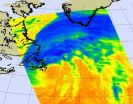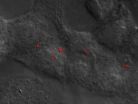(Press-News.org) Hurricane Igor may have transitioned into a post-tropical hurricane late yesterday, but when he approached Newfoundland, Canada and merged with an area of low pressure it resulted in heavy rainfall throughout the region. NASA satellites captured Igor's northern march toward the Labrador Sea yesterday.
NASA's Terra and Aqua satellites captured visible and infrared images of Hurricane Igor yesterday as he brought heavy rainfall into northeastern Canada. A visible image of Hurricane Igor over Newfoundland, Canada was captured by the Moderate Resolution Imaging Spectroradiometer (MODIS) instrument on NASA's Terra satellite on Sept. 21 at 14:15 UTC (10:15 a.m. EDT). At that time, Igor had re-strengthened and an eye appeared on the visible imagery.
One and a half hours later, at 1553 UTC (11:53 a.m. EDT), NASA's Aqua satellite captured an infrared image of Hurricane Igor's cold thunderstorms that extended from Labrador, Canada eastward over southern Greenland. Igor was moving northward toward into the Labrador Sea toward Labrador and Baffin Island.
At 5 p.m. EDT on Sept. 21, Igor completed its post-tropical transition and its core went from a warm core, tropical system to a cold core system. At that time, he was 125 miles north-northeast of St. Johns, Newfoundland, Canada near 49.3 North and 51.7 West. Igor still had sustained hurricane-force winds of 80 mph although they are expected to weaken today, Sept. 22. Igor's minimum central pressure was 950 millibars, and he was moving north-northeast near a super-speedy 39 mph!
As Igor moved north his circulation continued increase. By 5 p.m. EDT on Sept. 21, tropical-storm force winds extended outward up to 520 miles from its center making the system over 1,000 miles wide!
Environment Canada noted that Hurricane Igor passed just south and east of Newfoundland on Tuesday, Sept. 21 and brought heavy rain and strong winds. Heavy rainfall extended far north and west of Igor's center as it neared Newfoundland, and hurricane-force winds were reported even into the evening.
A trough of low pressure (an elongated area of low pressure) that had passed over Newfoundland the day before (Monday) Igor arrived was still in the vicinity and interacted with the hurricane. The trough took moisture and energy from Igor and caused more heavy rainfall over the region. There were reports of extensive flooding, power outages and wind damage throughout the eastern half of Newfoundland over the last two days. Igor is one storm that the Atlantic will not miss.
INFORMATION:
Huge post-tropical Hurricane Igor drenched Newfoundland, Canada
2010-09-22
ELSE PRESS RELEASES FROM THIS DATE:
Human-powered ornithopter becomes first ever to achieve sustained flight
2010-09-22
TORONTO, ON – Aviation history was made when the University of Toronto's human-powered aircraft with flapping wings became the first of its kind to fly continuously.
The "Snowbird" performed its record-breaking flight on August 2 at the Great Lakes Gliding Club in Tottenham, Ont., witnessed by the vice-president (Canada) of the Fédération Aéronautique Internationale (FAI), the world-governing body for air sports and aeronautical world records. The official record claim was filed this month, and the FAI is expected to confirm the ornithopter's world record at its meeting ...
Humanized mice may provide clues to better prevent and treat typhoid fever
2010-09-22
Better treatments and prevention for typhoid fever may emerge from a laboratory model that has just been developed for the disease. The model is based on transplanting human immune stem cells from umbilical cord blood into mice that are susceptible to infections.
The transplanted cells live alongside the mouse's own immune system. Although mice are normally resistant to the dangerous strain of Salmonella that causes typhoid fever, the bacteria are able to reproduce in the mice that have received transplanted human cells.
Because typhoid fever affects only humans, ...
Positive behavioral interventions programs found to improve student behavior and learning
2010-09-22
Los Angeles, CA (September 22, 2010) Adopting the evidence-based procedures of School-Wide Positive Behavioral Interventions and Supports (SWPBIS) helped 21 elementary schools reduce student suspensions, office discipline referrals and improve student academic achievement, according to a study published in the July 2010 issue of the Journal of Positive Behavior Interventions. SWPBIS is a rapidly expanding approach to improving educational environments that is estimated to be used in more than 9,000 schools nation-wide
Researchers at the Johns Hopkins Center for the Prevention ...
Experience, privacy guide how people choose online news
2010-09-22
Adjustments, applications and other tools allow users to configure preferences and use services such as iGoogle and Yahoo to control and customize the news they consume online. These tools can make online experiences more efficient and productive, but they do not ensure that users will be consistently pleased with their selections, according to Penn State researchers.
"There is a major push toward customization in the marketplace because designers assume that more customization is better, but our research shows that only some users prefer customization," said S. Shyam ...
Losing your religion deemed unhealthy
2010-09-22
People who leave strict religious groups are more likely to say their health is worse than members who remain in the group, according to a Penn State researcher.
The percentage of people who left a strict religious group and reported they were in excellent health was about half that of people who stayed in the group, said Christopher Scheitle, senior research assistant, in sociology.
"Previous research showed some association between belonging to a religious group and positive health outcomes," Scheitle said. "We became interested in what would happen to your health ...
Gum disease found to be significant public health concern
2010-09-22
September 21, 2010 – Chicago – The prevalence of periodontal disease in the United States may be significantly higher than originally estimated. Research published in the Journal of Dental Research from the Centers for Disease Control and Prevention (CDC) and the American Academy of Periodontology (AAP) suggests that the prevalence of periodontal disease may have been underestimated by as much as 50 percent. The implication is that more American adults may suffer from moderate to severe gum disease than previously thought.
In a National Health and Nutrition Examination ...
Study: Doctors overprescribe antibiotics for respiratory infections
2010-09-22
Doctors frequently misuse antibiotics when treating patients hospitalized with respiratory tract infections (RTIs), according to a study to be published in the November issue of Infection Control and Hospital Epidemiology.
The study, which tracked patients in two Pennsylvania hospitals, found that doctors often use antibiotics to treat patients whose infections are known to be caused by viruses. The findings are alarming because antibiotics are not effective against viruses, and antibiotic overuse has been linked to the development of resistant bacterial strains.
"[T]hese ...
Introducing 'Champagne,' new disease-resistant fig
2010-09-22
BATON ROUGE, LA—The ancient fig tree, first imported to the United States during the 16th century, thrives in areas of California and the South Atlantic and Gulf Coast areas of the U.S. One of the most popular trees grown in Southern backyards, fig is favored for its versatile fruit and low-maintenance production.
Charles E. Johnson, Ed O'Rourke, and James E. Boudreaux, from the Louisiana State University Agricultural Center in Baton Rouge, introduced a new fig they named "Champagne" in a recent issue of HortScience. According to the report, the new fig performed well ...
Food for thought, er, well ...
2010-09-22
Ever wonder why it's such an effort to forget about work while on vacation or to silence that annoying song that's playing over and over in your head?
Mathematicians at Case Western Reserve University may have part of the answer.
They've found that just as thinking burns energy, stopping a thought burns energy - like stopping a truck on a downhill slope.
"Maybe this explains why it is so tiring to relax and think about nothing," said Daniela Calvetti, professor of mathematics, and one of the authors of a new brain study. Their work is published in an advanced online ...
NASA study shows desert dust cuts Colorado River flow
2010-09-22
Snowmelt in the Colorado River basin is occurring earlier, reducing runoff and the amount of crucial water available downstream. A new study shows this is due to increased dust caused by human activities in the region during the past 150 years.
The study, led by a NASA scientist and funded by the agency and the National Science Foundation, showed peak spring runoff now comes three weeks earlier than before the region was settled and soils were disturbed. Annual runoff is lower by more than five percent on average compared to pre-settlement levels.
The findings have ...

